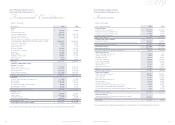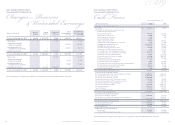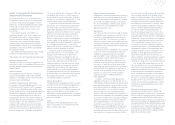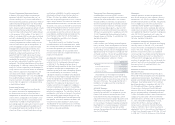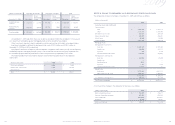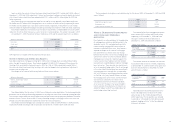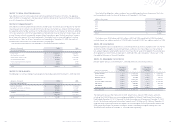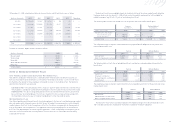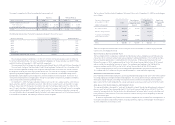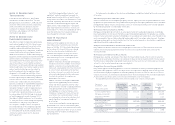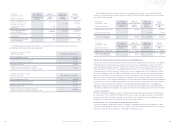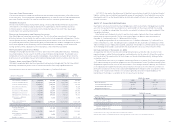Navy Federal Credit Union 2009 Annual Report Download - page 23
Download and view the complete annual report
Please find page 23 of the 2009 Navy Federal Credit Union annual report below. You can navigate through the pages in the report by either clicking on the pages listed below, or by using the keyword search tool below to find specific information within the annual report.
23
2009 Financial Section
Note 13: Related Party
Transactions
In the normal course of business, Navy Federal
extends loans to credit union officials. The total
principal amount at December 31, 2009 and 2008
was $30.6 million and $32.8 million, respectively.
Credit union officials are defined as volunteer
members of the Board of Directors and board
committees, and employees with the title of
Vice President and above.
Note 14: Reserves and
Undivided Earnings
Navy Federal is subject to regulatory capital require-
ments administered by the NCUA. Failure to meet
minimum capital requirements can initiate certain
mandatory and possibly additional discretionary
actions by regulators that, if undertaken, could have
a direct material effect on Navy Federal's consoli-
dated financial statements. Under capital adequacy
regulations and the regulatory framework for prompt
corrective action, Navy Federal must meet specific
capital requirements that involve quantitative meas-
ures of Navy Federal’s assets, liabilities and certain
commitments as calculated under generally accepted
accounting principles. Navy Federal’s capital amounts
and net worth classification are also subject to
qualitative judgments by the regulators about
components, risk weightings and other factors.
Quantitative measures established by regulation
to ensure capital adequacy require Navy Federal to
maintain minimum amounts and ratios of net worth
to total assets. Credit unions are also required to
calculate a risk-based net worth (RBNW) requirement
that establishes whether the credit union will be
considered “complex” under the regulatory frame-
work. A credit union is defined as “complex” if
the credit union’s quarter-end total assets exceed
ten million dollars ($10,000,000) and its risk-based
net worth requirement exceeds six percent (6%).
Navy Federal’s RBNW requirement as of December
31, 2009, was 6.39%, which exceeds the regulatory
threshold of 6% and places Navy Federal in
the “complex” category. There is no impact to
Navy Federal based on the complex designation
because our statutory net worth ratio qualifies us
as “well capitalized” by NCUA standards and our
statutory net worth exceeds our risk-based net
worth requirement.
The NCUA categorized Navy Federal as “well
capitalized” under the regulatory framework for
prompt corrective action with a net worth to assets
ratio of 9.44% and 9.60% as of December 31, 2009
and 2008, respectively. Net worth for this calculation
is defined as undivided earnings plus regular and
capital reserves. To be categorized as “well capital-
ized,” Navy Federal must maintain a minimum net
worth ratio of 7%. There are no conditions or events
since that notification that management believes
have changed the institution’s category.
Note 15: Fair Value
Measurement
Effective with the adoption of ASC 820-10, Fair
Value Measurements and Disclosures (formerly
known as SFAS No. 157), Navy Federal determines
the fair values of its financial instruments based
on the fair value hierarchy established in that
standard, which requires an entity to maximize
the use of quoted prices and observable inputs
when measuring fair value. A description of the
fair value hierarchy is as follows:
4Level 1—Valuation is based upon quoted prices
for identical instruments traded in active markets.
4Level 2—Valuation is based upon observable
inputs such as quoted prices for similar instruments
in active markets, quoted prices for identical
or similar instruments in markets that are not
active and model-based valuation techniques
for which all significant assumptions are
observable in the market.
4Level 3—Valuation is based upon unobservable
inputs that are supported by little or no market
activity and that are significant to the fair value
of the instrument. Valuation is typically performed
using pricing models, discounted cash flow
methodologies or similar techniques, which
incorporate management’s own estimates of
assumptions that market participants would
use in pricing the instrument or valuations that
require significant management judgment
or estimation.
Certain assets and liabilities may be required to
be measured at fair value on a non-recurring basis.
These non-recurring fair value measurements usually
result from the application of lower of cost or market
accounting or the write-down of individual assets
due to impairment.
Navy Federal Credit Union
22
2009
The following is a description of the valuation methodologies used by Navy Federal for the assets measured
at fair value:
Securities Available for Sale (AFS)
Securities available for sale are composed of agency securities. Agency securities are agency debentures issued
by government-sponsored entities. Navy Federal receives pricing for these agency debentures from a third-party
pricing provider. Agency securities are classified as Level 2 in the fair value hierarchy as the valuation provided
by the third-party provider uses observable market data.
Mortgage Servicing Rights (MSRs)
Mortgage servicing rights do not trade in an active, open market with readily observable prices. Accordingly,
Navy Federal obtains the fair value of the MSRs using a third-party pricing provider. The provider uses a combi-
nation of market and income valuation methodologies. All assumptions are market driven. Once the preliminary
results are complete, they are further calibrated to observable market transactions, when they exist. Therefore,
mortgage servicing rights are classified within Level 3 of the fair value hierarchy as the valuation is model driven
and primarily based on unobservable inputs.
Derivative Commitments—Assets and Liabilities
Navy Federal uses derivative commitments to hedge against interest rate risk. These derivatives (assets and
liabilities) are valued using quoted market prices of similar assets and are classified within Level 2 of the
fair value hierarchy.
Mortgage Loans Awaiting Sale (MLAS)
Mortgage loans awaiting sale comprise those loans that Navy Federal intends either to sell or to securitize.
Prior to sale or securitization, MLAS loans are carried at the lower of cost or market (LOCOM). The fair value of
the MLAS loans is obtained by using quoted market prices of similar assets. As such, MLAS loans are classified
as Level 2 in the fair value hierarchy on a non-recurring basis.
Other Real Estate Owned (OREO)
Navy Federal acquires residential properties as a result of foreclosure or forfeiture and those properties are
classified as OREO properties. OREOs are subject to fair value adjustments applying lower of cost or market
(LOCOM) accounting by writing-down the individual property to current fair value less cost to sell. The fair
value less cost to sell is an estimated value based on relevant recent historical data that are unobservable inputs.
As such, OREO is classified as Level 3 in the fair value hierarchy on a non-recurring basis.
The table below presents the balance sheet items measured at fair value on a recurring basis:
Fair Value at
December 31, 2009
(dollars in thousands)
Quoted prices
in Active Markets
for Identical Assets
(Level 1)
Significant
Other Observable
Inputs
(Level 2)
Significant
Unobservable
Inputs
(Level 3)
Balance
as of
December 31,
2009
Securities available-for-sale $—$ 3,852,245 $—$ 3,852,245
Mortgage servicing rights — — 168,699 168,699
Other assets—Derivative
commitments — 5,555 — 5,555
Total assets at fair value
on a recurring basis —3,857,800 168,699 4,026,499
Other liabilities—Derivative
commitments — 2,048 — 2,048
Total liabilities at fair value
on a recurring basis $—$ 2,048 $—$ 2,048


